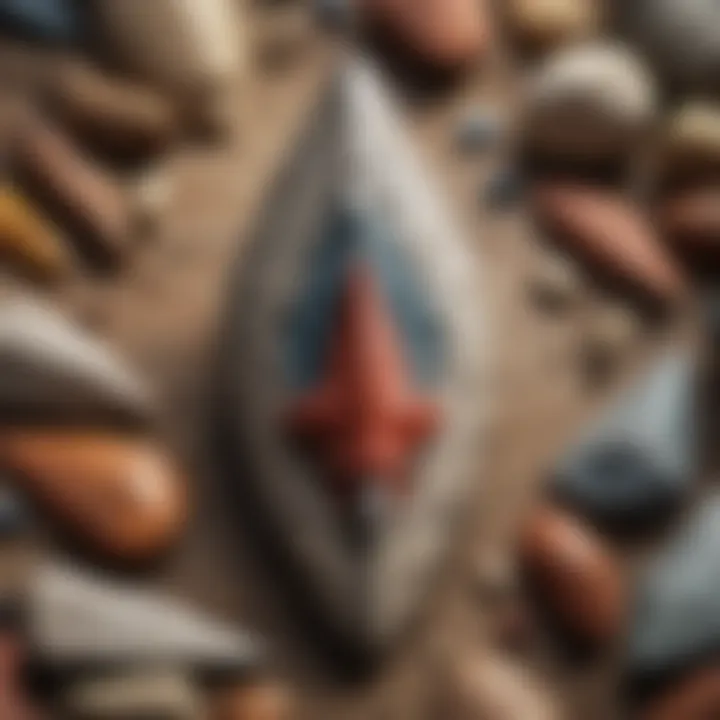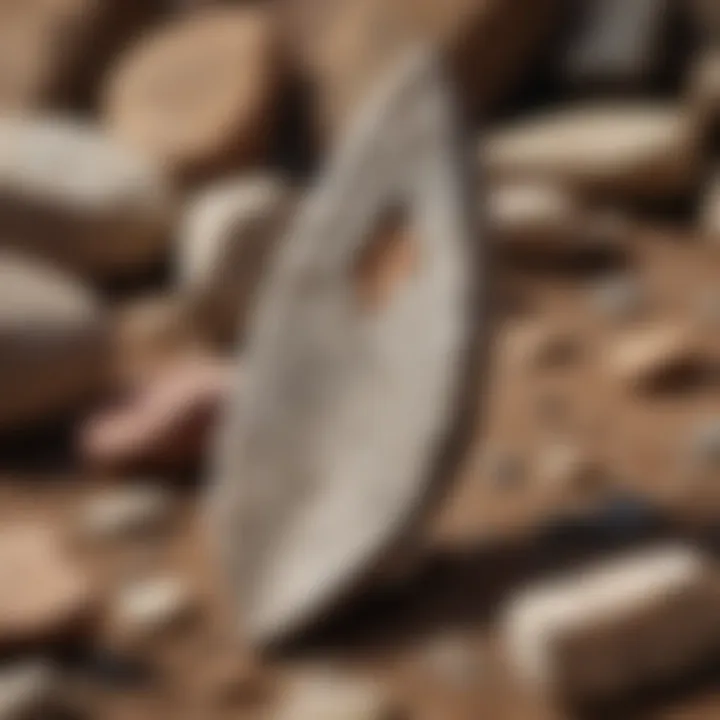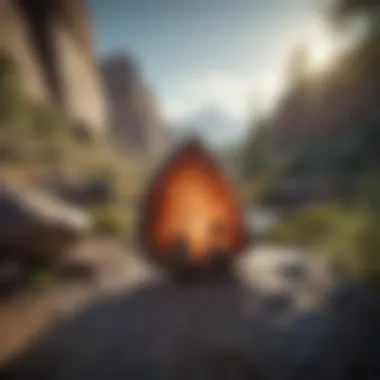Exploring the World of Stone Arrowhead Collecting


Intro
Collecting stone arrowheads is not just a hobby for many; it's a journey through time that uncovers human ingenuity and ancient civilizations. Enthusiasts from various backgrounds find themselves drawn to these small artifacts, each one telling a story steeped in history. To the untrained eye, they might seem like mere rocks, but to collectors, these pieces of stone represent skill, survival, and cultural significance.
Navigating the world of arrowhead collecting involves understanding their historical context, distinguishing between styles and materials, and knowing the right techniques for preservation, which is paramount for maintaining their integrity over the years. In this article, we’ll explore these themes, offering valuable insights for both novice and experienced collectors alike.
Prelude to Stone Arrowheads
Stone arrowheads have long captured human fascination, serving as both artifacts of ancient ingenuity and as treasures for modern-day collectors. Within these small, sharp tokens lies a narrative woven through time—representing survival, craftsmanship, and cultural identity. Understanding the nuances of collecting stone arrowheads becomes essential for any aficionado or novice who wishes to appreciate their place in history and in contemporary culture.
The act of collecting these items provides a multifaceted experience, engaging one’s mind and senses. From the tactile pleasure of handling a well-crafted piece to the thrill of discovery during a dig, stone arrowheads are not merely collectibles; they are a gateway to understanding the lives of the people who created them. When you dive deeper into collecting arrowheads, you also explore the historical contexts that birthed these artifacts, the materials used to craft them, and the regional variations that tell unique stories.
In this article, we aim to illuminate the complexities surrounding arrowhead collection. We’ll cover why these objects matter, the various types available, and strategies for building a meaningful collection. Importantly, we will also address the cultural significance and the ethics involved in collecting these fascinating remnants of human history.
As we move further, keep in mind that each arrowhead, regardless of its origin, carries a portion of a story waiting to be unraveled.
What Are Stone Arrowheads?
Stone arrowheads are pointed tools made primarily from various types of stones such as flint, obsidian, or chert. These implements were historically used for hunting and warfare, playing a critical role in the lives of ancient peoples. Typically, an arrowhead would be affixed to a wooden shaft to form an arrow, although they have also been used as spearheads and other types of projectile tools.
The quality of an arrowhead significantly relies on the material chosen. For example, flint, known for its ability to be chipped into sharp edges, offers a fine balance of lightness and durability, making it a popular choice among indigenous tribes.
When it comes to shape and size, the variability is vast. Each design serves specific purposes, whether optimizing aerodynamics for long-range shots or maximizing lethality in close combat. Moreover, the way a stone is worked, known as flintknapping, is an art form in itself; it requires considerable skill and practice. A beautifully knapped arrowhead can be a joy to behold, with crisp lines and smooth finishes showcasing the knapper's craftsmanship.
Historical Significance of Arrowheads
Arrowheads are not just tools; they are artifacts deeply intertwined with the history of human civilization. They narrate the evolution of hunting practices, shifts in societal structures, and even interactions between different cultures. From the moment early humans picked up stone to craft their first projectile, a world of significance emerged.
In various cultures, arrowheads have been used in rituals and offerings, symbolizing strength, valor, and the hunt. They serve as markers of territory and tools of survival, revealing insights into the lives of the people who relied on them.
"The stone arrowhead stands silent, yet its whispers echo tales of ancient hunts, battles fought, and lives lived."
As we peel back the layers of history, we discover how these artifacts reflect broader technological advancements. From the transition of materials and designs to the development of trade networks that facilitated the exchange of these tools, arrowheads have played a critical role in the advancement of societies.
The study of stone arrowheads offers invaluable perspectives on the past, providing clues not just to survival but to the very essence of humanity’s narrative. As you embark on the journey of collecting, remember that each piece you acquire is tied to centuries of history, inviting you to explore and connect with the richness of human experience.
Types of Stone Arrowheads
Understanding the various types of stone arrowheads is crucial for anyone serious about collecting these artifacts. Each type not only embodies a specific cultural history but also showcases different technological advancements in flintknapping. The materials and formations of arrowheads can vary widely, and being aware of these distinctions helps collectors appreciate the intricacies of their pieces. Furthermore, knowing about different regional variations can guide collectors in making informed purchasing decisions.
Materials Used in Manufacturing
Flint
Flint has been a preferred material for arrowheads for thousands of years. Its ability to break with a sharp edge lends it a distinctive edge, hence why ancient crafters favored it. A key characteristic of flint is its relative abundance in various locales, making it accessible to early humans. When considering the benefits of flint, collectors might find its historical significance particularly compelling: many ancient cultures relied on flint tools for survival. However, flint can vary in quality, with higher-quality flint yielding sharper, more durable arrowheads, while lower-grade options may be less effective.
Obsidian
Obsidian, unlike flint, is volcanic glass that splinters in a very sharp manner once knapped. Its fineness often leads to the creation of razor-sharp points, making it exceptionally lethal as a hunting tool. Collectors often seek obsidian arrowheads for their stunning glass-like finish, and they stand out for their color variety, which can range from deep black to shimmering rainbow effects depending on the iron and mineral content. One downside of obsidian, however, is its brittleness. It can chip or break under pressure, which raises concerns about the longevity of displayed pieces.
Chert
Chert is a sedimentary rock similar to flint but exhibits a more irregular texture and often has swirls or bands of color. Its formation and hardness can vary significantly, making it less predictable compared to flint and obsidian. Chert has been used around the globe, but it may not have the same level of sharpness as obsidian. A notable feature of chert arrowheads is their unique appearance, which can add character to a collection. Despite this uniqueness, collectors might discover that less attention is given to chert in the market, which can make these arrowheads a less desirable but still interesting option.
Variations by Region
Native American Variants
Native American arrowheads vary widely across the continent, reflecting the diverse cultures and environments from which they originated. These arrowheads often feature sophisticated craftsmanship, showcasing intricate patterns and shapes. A striking attribute of Native American variants is their ties to specific tribes; each tribe had unique designs and techniques, contributing to an enriched history of different styles. Collectors often find these pieces particularly valuable due to their connection to native cultures, but one must be cautious about reproductions. Authentic pieces can command high prices and are cherished for their historical importance.
European Arrowheads
European arrowheads carry their own storytelling, often linked to different time periods and conflicts. Crafted from various materials, including flint and bronze, these artifacts reflect the technological advancements of their era. A defining characteristic of European arrowheads is their function during warfare as well as hunting, which shaped their design. Collectors often pursue these pieces for their rich narrative and as tangible connections to historical practices; however, understanding the provenance is essential here due to the prevalence of replicas on the market.


Pacific Island Arrowheads
Pacific Island arrowheads represent a unique aspect of weapon technology that evolved in isolation. Many early inhabitants utilized local materials like basalt and coral, resulting in distinctive forms and adaptations. The key aspect of Pacific Island arrowheads is that they often served both practical and ceremonial purposes; some were not just tools but also status symbols. Collectors intrigued by island cultures find these pieces fascinating. Still, the rarity can make them harder to find and may lead to higher prices when they surface on the market.
Collecting Stone Arrowheads
Collecting stone arrowheads can be a fulfilling endeavor for both history buffs and casual hobbyists. The importance of this topic lies in the intricate relationship between these artifacts and their cultural backgrounds. Arrowheads often embody centuries of human ingenuity and adaptation, making them not just items of beauty, but stories waiting to be uncovered. As a collector, engaging with these relics can lead to a deeper understanding of the societies that created them, as well as a tangible connection to the past.
One significant aspect to consider is the wide array of styles and materials that exist, each telling its own tale of the people who crafted them. By selecting which arrowheads to pursue, collectors have the opportunity to truly personalize their collections. There’s a myriad of benefits that can come from collecting, including enhancing your knowledge of archaeology, connecting with other enthusiasts, and possibly even acquiring artifacts that appreciate in value over time. Despite these advantages, it is essential to approach the topic with careful thought regarding ethics and legalities surrounding artifact collection.
Setting Personal Goals as a Collector
When embarking on the journey of collecting stone arrowheads, setting personal goals is paramount. What drives your interest? Are you drawn to the aesthetic qualities of the arrowheads, their historical significance, or the thrill of hunting for unique pieces? Having a clear focus will guide the direction of your collection.
Taking time to define your interests allows you to avoid haphazardly accumulating pieces that don’t resonate with you. For instance, some collectors may choose to focus solely on a specific region, such as Native American artifacts, whereas others might want to explore various types from around the globe. Whatever your goals, balance your ambition with realism; you might not uncover rare finds every day.
Building a Collection: Strategies and Tips
Navigating the world of arrowhead collection can seem daunting, but with the right strategies and tips, it becomes a more manageable task.
Selecting Themes
Selecting a theme for your collection can significantly enrich your experience. Focusing on specific cultures or time periods offers collectors the chance to dive deeper into the unique histories associated with each item. Themes can range widely; for instance, one might focus on arrowheads used in ancient hunting practices or those crafted in a particular geographic area.
Benefits of Selecting Themes
Choosing a theme fosters a sense of interconnectedness among the pieces in your collection. It allows for an organized display, making it easier to showcase your knowledge of each artifact's history. Additionally, it can lead to opportunities for learning, as you may find yourself researching to fill in the gaps of information about each item.
Considerations
On the flip side, restricting yourself to a specific theme might limit the diversity of your collection. While themes help maintain focus, remember to stay open to unexpected finds that may not fit your original criteria. A seemingly unrelated arrowhead could surprise you with its backstory, adding yet more depth.
Diversifying Materials
Diversifying materials in your collection is another strategy that offers both aesthetic and educational benefits. Various raw materials like flint, obsidian, and chert can provide unique qualities in arrowheads. Engaging with different materials can lead to richer conversations around how these materials affect crafting techniques and overall effectiveness as tools.
Key Features of Diversifying Materials
By expanding your collection to include various materials, you open up a world of differing textures, colors, and shapes. Such variety not only makes for a visually appealing display but also prompts curiosity among other collectors and visitors.
Advantages and Challenges
However, collecting a wide range of materials also comes with its challenges. Materials can vary in availability, pricing, and authenticity. While it can be thrilling to hunt for a particular type made from a rare material, it can also be costly or difficult to acquire. As you diversify, keep an eye on market trends and accessibility, ensuring you're navigating the landscape wisely.
"To every collector, every arrowhead has its own story; it simply takes the right light to shine on it."
Through careful consideration of themes and materials, collecting stone arrowheads can become a complex yet rewarding journey. As you build and refine your collection, remember that each piece is not just a product of its time but a bridge to the past, offering insights that enrich your own understanding of history.
Where to Buy Stone Arrowheads
When it comes to collecting stone arrowheads, the pathway to procurement is just as crucial as understanding their historical importance. Knowing where to buy them can determine not only the quality of your collection but also its authenticity. With a meticulous selection of sources, collectors can uncover treasures from various eras, enhancing their appreciation of these artifacts.
Online Auctions and Marketplaces
In the digital age, online platforms have become a bustling hub for collectors looking for stone arrowheads. Websites such as eBay and Etsy provide a wide array of products that change almost daily. These semi-anonymous venues often feature sellers from different regions, showcasing arrowheads that tell stories of diverse cultures and historical contexts.
However, with great opportunity comes great caution. When sorting through listings, it's paramount to scrutinize sellers' ratings and read reviews. A reputable seller usually has a history of positive feedback, indicating reliability.
Furthermore, understanding the nuances of bidding on online auctions can greatly enhance your purchasing experience:
- Do your research: Familiarize yourself with similar items to know what constitutes a fair price.
- Ask questions: If something seems off, don’t hesitate to message the seller. Clarifying doubts before committing can prevent buyer's remorse.
- Beware of shipping costs: Sometimes, a low price can be offset by unexpectedly high shipping fees.
In a realm filled with variable prices and authenticity levels, do not take the seller’s word for it when it comes to the arrowhead’s origin or age. Always cross-reference information whenever possible, relying on multiple sources or expert opinions.
Specialty Shops and Shows
For those who prefer a more hands-on approach, specialty shops and collector shows offer a treasure trove of stone arrowheads. These venues often feature knowledgeable staff with a passion for archaeology and history, able to provide insights that enhance your understanding of your purchase.
Visiting local shops can yield a couple of benefits:
- Direct Inspection: You get to hold and examine the arrowheads closely. This tactile experience helps you to assess their condition, authenticity, and craftsmanship in a way photographs simply cannot.
- Expert Advice: Engaging with staff members can lead to invaluable information; they may share tips on caring for your collection or let you know about upcoming events where rare finds might be available.
Collector shows, on the other hand, present an opportunity to mingle with fellow enthusiasts while browsing a vast array of arrowheads. These events sometimes even feature workshops or lectures, offering deeper insights into the world of collecting. They allow unique networking opportunities:


- Exchange knowledge: Conversations with other collectors can lead to new insights or even prospective trades.
- Stay updated: You’ll find out about emerging trends or new resources that can improve your collection strategies.
"Always follow your instincts about a potential purchase, whether online or at shows. If something feels off, it's often best to walk away."
Evaluating Authenticity
When delving into the world of stone arrowhead collecting, evaluating authenticity stands out as a critical component. Authentic arrowheads are not just artifacts; they are windows into the past—representing the craftsmanship and ingenuity of ancient peoples. As such, collectors have a profound responsibility to discern the genuine from the counterfeit. This practice not only preserves the historical integrity of these artifacts but also safeguards the collector's investment.
Common Counterfeits and How to Identify Them
Navigating the murky waters of counterfeits can be daunting. However, familiarizing yourself with the most common types can significantly ease this process. Some counterfeit arrowheads precision-manufactured in factories attempt to mimic the authentic characteristics of ancient pieces, often available at attractive prices.
To better identify these counterfeits, consider the following:
- Material Analysis: Real stone arrowheads are made from specific materials like flint, obsidian, or chert. If a piece feels unusually lightweight or has an odd sheen, it might be a resin or synthetic material.
- Craftsmanship Observations: Authentic arrowheads showcase natural imperfections and variations in flaking patterns; machine-finished pieces may display unnaturally smooth edges.
- Aging Indicators: Genuine artifacts often bear the signs of wear and tear from centuries of existence, like patina or mineral deposits. Newer replicas may lack this complexity.
"The real beauty of collecting is to connect with history. Understanding what you're holding can deepen that connection tremendously."
The Role of Appraisals and Expert Opinions
Seeking expert opinions becomes essential when assessing authenticity. Certified appraisers can leverage their experience to provide insights that might be elusive to the average collector. They look at the provenance and can often trace the history or origin of a piece, adding another layer of value.
Moreover, consider these benefits of utilizing appraisals:
- Validating Investments: Appraisals can confirm authenticity, ensuring that your financial input is safeguarded.
- Insurance Assessments: Having a documented appraisal provides necessary information for proper insurance coverage should damage or theft occur.
- Resale Value: An expert valuation can help establish a piece's worth in the collector's market, making your future transactions smoother.
In summary, evaluating authenticity isn't just a chore—it's a vital part of the collector's journey that enhances both the enjoyment of the artifacts and the responsibility of stewardship over these significant pieces of history.
Care and Preservation of Stone Arrowheads
Collecting stone arrowheads can be an enriching hobby that connects you to history and culture. But as with any collectible artifact, proper care and preservation are crucial to maintain their integrity and value over time. Stone arrowheads are not just objects of aesthetic beauty; they hold significant historical and cultural value. When you preserve them correctly, you not only protect your investment but also ensure that future generations can appreciate their significance.
The importance of maintaining these artifacts cannot be overstated. Without appropriate care, environmental factors—like moisture, light, and temperature changes—can degrade stone materials, leading to irreversible damage. This makes the knowledge of preservation techniques vital for any serious collector. Moreover, understanding how to care for arrowheads often adds to the collector’s enjoyment and depth of knowledge about the items they cherish.
Cleaning Tips for Collectors
Cleaning stone arrowheads requires a careful hand and a discerning eye. Here are some steps to keep in mind:
- Use Water: For basic cleaning, plain water is often your best bet. Use a soft brush to gently remove dirt and debris without scratching the surface. Avoid abrasive materials.
- Avoid Chemicals: Stay away from strong chemicals or cleaners. These can react negatively with stone materials and lead to deterioration, ruining an otherwise beautiful artifact.
- Drying: After rinsing, make sure to dry the arrowheads thoroughly. Use a soft cloth or let them air dry. This prevents the buildup of moisture that could harm the stone over time.
- Spot Testing: If you’re ever unsure about a cleaner, test it on an inconspicuous area first. This way, you can ensure it won’t damage the stone.
- Storage: When not on display, store the arrowheads in a breathable container away from humidity and direct sunlight to minimize the potential for damage. Silica gel packets can help absorb moisture.
"Caring for your stone artifacts is not just about restoration; it's about respect for history and the people who crafted them."
Best Practices for Displaying Arrowheads
Once your collection is clean, displaying these remarkable pieces can be a rewarding experience in itself. Here are some best practices for showcasing your arrowheads:
- Proper Display Cases: Use glass or acrylic display cases that block UV rays to prevent fading and damage from sun exposure.
- Avoid Direct Sunlight: Position displays away from direct sunlight. Natural light is beautiful, but it can lead to discoloration and wear over time.
- Humidity Control: Keep humidity levels steady, ideally between 35-50%. Too much humidity can encourage mold, while too little can cause cracks and crumbling.
- Non-Abrasive Stands: If using stands or holders, ensure they are made from non-abrasive materials. This prevents any scratches or damage to the arrowheads as you change or rearrange them.
- Labeling: If you’re featuring your collection, consider labeling each piece with its origin, age, and any other relevant historical information. This not only adds educational value but also enhances the storytelling aspect of your display.
By applying these practices, you can ensure that your stone arrowheads will remain in excellent condition for years to come, enhancing both your collection and your experience as a collector.
Cultural Significance of Arrowheads
Arrowheads aren't just relics of a bygone era; they're pieces of history embedded with stories and rich cultural significance. Each arrowhead that a collector holds is a link to the past, providing insights into the lives, craftsmanship, and even belief systems of ancient peoples. By appreciating their cultural backdrop, collectors can deepen their personal connection to these artifacts and understand the broader implications of their collection.
Because of their role in hunting and warfare, arrowheads symbolize survival and ingenuity. They remind us of the human experience, marked by the struggle for sustenance and security. This makes arrowheads a focal point for exploring the resilience of cultures through time, connecting collectors to the various peoples who once roamed the lands they now curate.
Arrowheads in History and Folklore
The historical context of arrowheads is vast and varied, serving not only as tools but as symbols embedded in folklore. Many indigenous cultures view arrowheads as sacred objects. For instance, among Native American tribes, arrowheads often appear in stories and legends. These narratives speak to the spiritual relationship that these communities hold with their natural environment. An arrowhead might symbolize a battle fought, an animal hunted, or a protection charm.
Different regions have unique tales tied to arrowheads. In many cultures, they were thought to embody the spirits of those who fashioned them or even the game they hunted. This gives arrowheads not just a historical significance but also a ritualistic one. They were sometimes placed in burial grounds to accompany the deceased, ensuring safe passage to the afterlife.
"Every stone arrowhead is a testament to human resilience and creativity. It speaks volumes of the world that came before us."
Modern Symbolism and Usage


In contemporary society, arrowheads take on a different kind of resonance. While they once were practical tools, today they are often seen as signs of craftsmanship and art. Many artisans create replicas or artistic interpretations of traditional arrowheads, emphasizing the cultural heritage while promoting the art of flintknapping — the process of crafting stone tools.
Moreover, arrowheads frequently find their way into the realms of fashion and design. Jewelry featuring arrowhead motifs has gained popularity, symbolizing strength, protection, and a connection to heritage. Collectors may also use them in home decor, transforming these ancient artifacts into conversation starters that blend history with personal style.
Arrowheads are not merely historical items; they resonate with deeper meanings in today’s context, embodying the struggle, story, and continuity of human culture. Collectors, therefore, play a crucial role in preserving these artifacts, not just for their aesthetic value but also to ensure that these stories continue to be told, reminding future generations of the resilience and inventiveness that define the human spirit.
Legal Considerations in Collecting
When it comes to building a collection of stone arrowheads, understanding the legal landscape isn't just a footnote—it's a crucial chapter. The legal considerations in collecting artifacts like stone arrowheads play a pivotal role in ensuring that your passion doesn’t stray into murky waters. Whether you're a seasoned collector or just starting, knowing the laws can save you from potential legal headaches down the line.
Understanding the Laws Surrounding Artifact Collection
Navigating the legalities surrounding artifact collection might seem like walking through a minefield, but in reality, it entails a few straightforward principles. Different countries, and even states or regions, have their own regulations that dictate what collectors can and cannot do. For instance, in the United States, it's generally prohibited to collect artifacts from federal lands without permission. This means that wandering into national parks or similar protected areas with a digging tool is a definite no-go. Moreover, some states have stricter laws; for example, in Arizona, collecting artifacts from archaeological sites can lead to hefty fines.
In addition to this, many countries have specific laws that govern the export and import of cultural artifacts. If you’re thinking of expanding your collection internationally, it’s crucial to educate yourself about the laws of the countries involved. Ignorance of the law often does not protect you from penalties. Collectors need to be especially mindful of antiquities laws where items are considered national treasures, as any renegade action can result in legal repercussions.
Ethics and Responsibility of Collectors
Being a responsible collector entails more than just knowing the laws—it involves adhering to ethical standards that respect cultural heritage. Collectors ought to acknowledge that artifacts hold significant historical and cultural value, not merely monetary worth. This mindset should guide your collecting practices, from sourcing to displaying items in your collection.
Ethically, collectors should avoid purchasing items with dubious provenance. If an arrowhead's backstory involves illicit excavation or the dismissal of cultural significance, it’s better to pass. Instead, focus on acquiring pieces whose origins are well-documented, such as those sourced from reputable dealers or established auctions. By doing so, you contribute positively to the community rather than fueling a market that exploits cultural heritage.
The responsibility of collectors extends into preservation as well. It’s not just about owning these artifacts; it’s about caring for them properly and ensuring they retain their value and integrity over time. Knowing how to maintain your collection, and understanding the importance of only sourcing legal and ethically acquired artifacts, fortifies your standing in the collecting community.
"Legislation is often complicated, but with due diligence and a sense of responsibility, collectors can navigate it effectively."
Ultimately, understanding the laws and adhering to ethical standards is essential for anyone involved in collecting stone arrowheads. This approach not only enriches your own experience but also safeguards the integrity of the artifacts that connect us to our past.
Community and Networking
In the intricate world of collecting stone arrowheads, the importance of community and networking cannot be overstated. The shared passion for these artifacts creates a sense of belonging and camaraderie among collectors. Engaging with fellow enthusiasts provides a wealth of knowledge and experiences that can vastly enhance one’s understanding and appreciation of arrowheads. It’s not merely about individual collections but also about contributing to a larger narrative surrounding these historical treasures.
Joining Local Collector Groups
Being part of local collector groups can be an enriching experience. These groups often host events where members share their findings, knowledge, and enthusiasm. One of the main benefits of joining such a group is the opportunity to meet people who have walked the same path, encountered similar challenges, and found success in their collecting endeavors. You can:
- Share tips and techniques about cleaning and preserving arrowheads.
- Learn to recognize genuine artifacts versus modern reproductions.
- Participate in organized hunts or excavations, which can lead to unique finds.
- Exchange duplicates or trade pieces to diversify your collection.
Moreover, local groups often serve as a platform to stay informed about upcoming events, such as local shows or auctions, ensuring that you never miss a chance to expand your collection.
Attending Symposiums and Conferences
Attending symposiums and conferences dedicated to stone arrowheads and artifacts is another excellent way to amplify your knowledge and connections. These gatherings often feature expert speakers who discuss various topics, from historical significance to techniques in identification and appraisal. Additionally, they usually have vendor areas where you can find rare arrowheads, tools, and literature.
Being present at these events allows you to:
- Hear firsthand from experts in archaeology and anthropology about the latest findings and trends in arrowhead collecting.
- Engage in discussions with seasoned collectors and scholars, fostering deep insights into the nuances of different cultures' arrowhead designs.
- Network with other attendees who share the same interests, opening doors to future collaborations or trade opportunities.
"Networking in the collecting community provides not just companionship but also invaluable insights that cannot be gleaned from books alone."
In summary, building a network through local collector groups and professional gatherings greatly enhances the experience of collecting stone arrowheads. By immersing yourself in these communities, you not only improve your collection but also contribute to the preservation and appreciation of these historic artifacts.
Ending
Gathering stone arrowheads can be rewarding, shaped by both joy and challenges. This journey encompasses much more than simple acquisition; it's a dive into history, culture, and personal connection. Collectors often discover a sense of purpose in preserving these artifacts and sharing knowledge with a broader community.
The Joys and Challenges of Collecting Stone Arrowheads
The thrill of uncovering a unique stone arrowhead in a field or at a local flea market can be exhilarating. Each piece carries with it a story, a past that sparks the imagination. Collectors often find themselves captivated by the craftsmanship and history behind these tools, leading to an enriching experience. The community that exists among collectors is part of what makes this hobby satisfying. Whether through local meets or online forums, the ability to discuss picks and techniques fosters not only friendships but also knowledge sharing.
On the flip side, challenges exist. Spotting fakes can be tricky, and not every seller has the best intentions. The hunt can also be physically demanding, requiring travel and sometimes a keen eye to spot hidden gems among countless unremarkable stones. Additionally, the ethical considerations in sourcing arrowheads must weigh on a collector's conscience, as it involves respecting cultural heritage and legal stipulations.
In light of these challenges, many find that the rewards far outweigh the hurdles. The satisfaction that comes from building a thoughtful, curated collection often leads to a deep appreciation for the artistry and history involved in each piece.
Looking Forward in the World of Collectibles
As interest in collecting stone arrowheads grows, the methods and avenues for acquiring these artifacts are evolving. Online platforms like eBay and specialty websites often offer more options than local shops, allowing collectors to explore a wider array of items. The increased access, however, also presents a dual-edge sword; while it opens doors for discovery, it also increases the likelihood of encountering counterfeit products. As such, education and awareness of the latest trends, both real and fraudulent, become crucial.
Trends indicate a growing focus on sustainability and ethical sourcing within the collecting community. Many collectors are seeking knowledge on how to ethically obtain artifacts, ensuring they respect historical and cultural contexts. Furthermore, technological advancements such as 3D printing are reshaping the way collectors interact with their hobbys.
In essence, looking ahead offers vast potential for collectors. With the rise of the online marketplace and increased interest in ethical collecting, the landscape is changing. Collectors who remain engaged and informed can navigate these changes, continuing to foster passion for stone arrowheads in the years to come.



